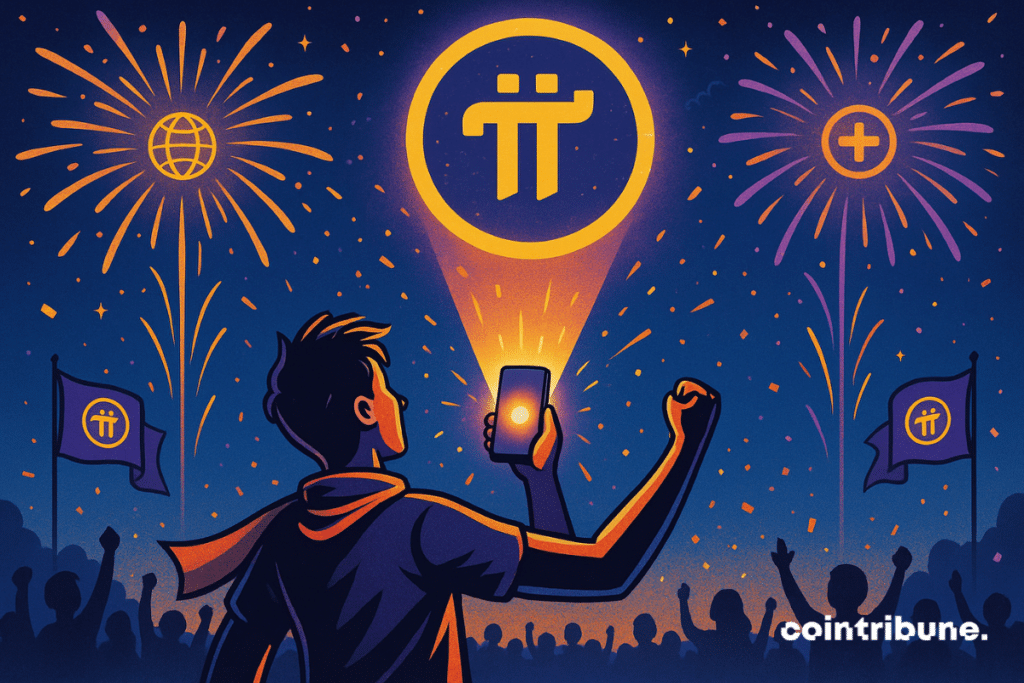Happy Pi2Day 2025! Today, Pi has introduced two exciting features to the ecosystem and provided various tech and product updates. First, Pi App Studio is an AI-powered platform that enables anyone to create Pi apps without coding—created to solve problems the world faces as AI… pic.twitter.com/6ZiVefdYsZ
— Pi Network (@PiCoreTeam) June 28, 2025
A
A
Pi2Day Brings Powerful New Tools To The Ecosystem
Sat 28 Jun 2025 ▪
5
min read ▪ by
Getting informed
▪
Summarize this article with:
On the occasion of Pi2Day, celebrated every June 28th, Pi Network unveiled two strategic features : an AI-powered no-code application creation tool and a community staking mechanism to promote projects. The initiative marks a shift towards a more accessible platform governed by its users. By betting on intelligent automation and decentralization of listings, Pi Network aims to redefine the rules of mobile-first Web3, at the intersection of technological innovation and community engagement.

In Brief
- On the occasion of Pi2Day 2025, Pi Network reveals two major new features.
- An AI-powered no-code tool now enables creating applications without coding.
- A new community staking system boosts app visibility within the Pi ecosystem.
- Pi Network relies on community and innovation to break free from centralized Web2 models.
Artificial Intelligence Serving App Creation : Launch of the Pi App Studio
While a rumor about a partnership with Google AI boosted Pi Network by +38 % this week, the highlight of Pi2Day 2025 was the unveiling of the Pi App Studio, a new no-code tool that allows any user to design an application simply using natural language instructions.
As indicated in the team’s press release, the goal is to allow everyone to “own and operate a business and product fully built around [their] knowledge and ideas, made possible by AI and supported by Pi’s blockchain ecosystem“.
Addressing non-developers, this crypto initiative aims to open application creation to a much broader audience than just experienced coders.
More concretely, Pi App Studio offers two main features at launch :
- Creation of specialized chatbots capable of delivering personalized responses based on instructions and the crypto user’s expertise, without coding ;
- An open-ended app generator (in beta), which automatically transforms a functional description written in natural language into a working application.
The objective is to lower technical barriers to decentralized innovation by combining generative artificial intelligence with blockchain logic. The studio could thus enable a new wave of entrepreneurs (teachers, content creators, influencers, or enthusiasts) to build digital services without traditional development.
The beta version rollout will be gradual, indicating a controlled ramp-up phase managed by the Pi Network team.
Community Staking as a Visibility Engine within the Pi Ecosystem
The second announcement of Pi2Day, just as structural, concerns the introduction of a new mechanism called Ecosystem Directory Staking. From now on, network users can stake their Pi tokens to influence the visibility of apps in the Pi Browser.
The Pi Network team states that “the more users stake on an application, the more it gains visibility in the directory“, thus reversing the classic logic of centralized platforms where promotion relies on advertising or opaque algorithms.
This feature, effective immediately, aims to offer increased exposure to crypto projects genuinely appreciated by the community, rather than merely by marketing budgets.
With this model, Pi Network seeks to put attention back into the hands of users, in an environment where visibility scarcity is often captured by the most powerful. “This staking system aligns exposure with real engagement and innovation“, specifies the team in their announcement.
In other words, it is the value perceived by the community that determines an application’s success, not acquisition spending. This is a significant paradigm shift, breaking from Web2 practices and reinforcing one of Pi’s founding pillars : the effective decentralization of distribution means.
In the medium term, this system could profoundly transform development dynamics within the Pi ecosystem. By giving users an active role in project exposure, Pi Network creates a community feedback loop where real interest prevails over centralized influence logics. This approach also paves the way for new monetization and community governance models, which could put an end to user anger related to various major bugs. It remains to be seen whether this initiative will ensure the quality of promoted applications and if crypto staking will become a true curation tool or merely a new form of economic power.
Maximize your Cointribune experience with our "Read to Earn" program! For every article you read, earn points and access exclusive rewards. Sign up now and start earning benefits.
A
A
Diplômé de Sciences Po Toulouse et titulaire d'une certification consultant blockchain délivrée par Alyra, j'ai rejoint l'aventure Cointribune en 2019. Convaincu du potentiel de la blockchain pour transformer de nombreux secteurs de l'économie, j'ai pris l'engagement de sensibiliser et d'informer le grand public sur cet écosystème en constante évolution. Mon objectif est de permettre à chacun de mieux comprendre la blockchain et de saisir les opportunités qu'elle offre. Je m'efforce chaque jour de fournir une analyse objective de l'actualité, de décrypter les tendances du marché, de relayer les dernières innovations technologiques et de mettre en perspective les enjeux économiques et sociétaux de cette révolution en marche.
DISCLAIMER
The views, thoughts, and opinions expressed in this article belong solely to the author, and should not be taken as investment advice. Do your own research before taking any investment decisions.